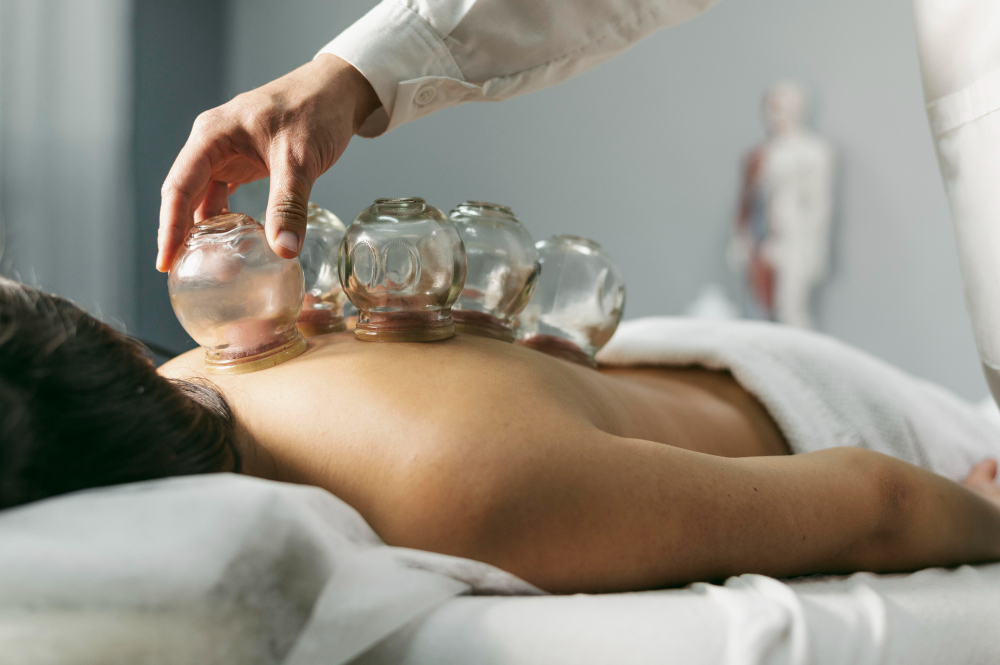Cupping

Cupping
Cupping refers to the medical technique of drawing suction against the skin for therapeutic purposes. “Dry cupping” involves suction against the skin, which can be stationary in spots or as mobile massage. Wet cupping includes pricking the skin to intentionally draw some blood from surface capillaries while drawing suction against the skin.
Cupping refers to the medical technique of drawing suction against the skin for therapeutic purposes. “Dry cupping” involves suction against the skin, which can be stationary in spots or as mobile massage. Wet cupping includes pricking the skin to intentionally draw some blood from surface capillaries while drawing suction against the skin. It is a technique that has been used for thousands of years by many cultures and civilizations, including in Ancient Greece, Egypt, the Middle East, Mesopotamia, and China. In Arabic, the procedure is known as “hijama”.
1. Detoxification of the blood / Stimulation of New Blood. As we age, we suffer from increased accumulation of toxins, stemming from poor diet and lifestyle, pharmaceutical drugs, pesticides, insecticides and other chemicals in our food supply, and environmental pollutants. Wet Cupping helps to remove these impurities and stimulate the bone marrow to produce new, healthier blood.
2. Pain Reduction/ Increased blood circulation. Areas of chronic pain often have localized areas of blood stagnation with high levels of inflammatory compounds. Both the suction against the skin as well as the drawing of blood help to withdraw inflammatory compounds and improve circulation.
3. Treatment of Numerous Diseases. Wet Cupping has been historically used to help with numerous diseases including migraines, blood disorders, hemophilia, post-stroke disorders, paralysis, cardio-vascular, hepatic, renal, rheumatic, menstrual disorders, and more.
* These statements have not been evaluated by the U.S. Food and Drug Administration.
Cupping is performed in several steps. The most common site for cupping is on the back, although it can also be performed in many other areas. The procedure involves sanitizing the area, making small incisions in the skin, and placing sanitary glass jars over the skin in which a flame is used to draw a vacuum, which helps to extract a small amount of stagnant blood. The procedure can be repeated if necessary, and the affected area of the skin is sanitized and bandaged. Slight pain is felt only while making the tiny incisions but not during the procedure itself.
When practiced in a clean & hygienic environment under the guidance of a qualified Doctor or Health Professional, wet cupping is very safe & relatively risk free. At Green Crescent Clinic, we provide a clean medical environment and collect a detailed medical history and inform patients of any potential risks or contraindications. You should inform the clinic of any medications taken and if you have any history of diabetes, low or high blood pressure, blood disorders, dizziness, fainting or anxiety. Wet Cupping may also be contraindicated in very young, pregnant or old patients who are too weak to lose blood.
NO. Wet Cupping involves suction to extract blood from surface capillaries, while donating blood involves pricked veins. Research studies conducted in Iran and Syria show that there are differences between venous and cupped blood. For example, cupped blood has greater health benefits because it extracts a higher percentage of abnormal and old red blood cells, LDL cholesterol, toxins, inflammatory compounds, and a lower percentage of white blood cells and iron.